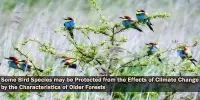Migrating birds rely on a variety of cues to navigate, including the Earth’s magnetic field. Studies have shown that disturbances in the magnetic field, such as those caused by solar flares or human-made sources like power lines and buildings, can disrupt a bird’s ability to navigate and lead to them going astray.
It seems sense that inclement weather occasionally makes birds disoriented during their yearly fall migrations, forcing them to end up in unfamiliar terrain. But why, even when weather is not a major factor, do birds travel far away from their usual routes?
One explanation is examined in a recent research from UCLA ecologists: even in ideal meteorological conditions, and particularly during fall migration, disruptions to the Earth’s magnetic field can cause birds to wander off, a phenomenon known as “vagrancy.” The research is published in Scientific Reports.
Because bird populations in North America are rapidly falling, examining the reasons for vagrancy may enable researchers to learn more about the dangers that birds experience and how they respond to those dangers. For example, birds that wind up in unfamiliar territory are likely to face challenges finding food and habitats that suit them, and may die as a result.
However, it may also help birds whose natural habitats are becoming inhospitable as a result of climate change by “accidentally” introducing the creatures to areas that are now more suitable for them.
We think the combination of high solar activity and geomagnetic disturbance leads to either a pause in migration or a switch to other cues during fall migration. Interestingly, birds that migrate during the day were generally exceptions to this rule they were more affected by solar activity.
Benjamin Tonelli
Earth’s magnetic field, which runs between the North and South Poles, is generated by several factors, both above and below the planet’s surface. Birds’ eyes’ magnetoreceptors may be used to sense magnetic fields, according to decades’ worth of laboratory studies. These conclusions are supported ecologically by the recent UCLA study.
“There’s increasing evidence that birds can actually see geomagnetic fields,” said Morgan Tingley, the paper’s corresponding author and a UCLA associate professor of ecology and evolutionary biology. “In familiar areas, birds may navigate by geography, but in some situations it’s easier to use geomagnetism.”
But when such magnetic fields are altered, birds’ ability to navigate using them may be hampered. Such disturbances may originate from various sources, including the magnetic field of the sun, particularly during times of increased solar activity, such as sunspots and solar flares.
“If the geomagnetic field experiences disturbance, it’s like using a distorted map that sends the birds off course,” Tingley said.
Lead researcher Benjamin Tonelli, a UCLA doctoral student, worked with Tingley and postdoctoral researcher Casey Youngflesh to compare data from 2.2 million birds, representing 152 species, that had been captured and released between 1960 and 2019 part of a United States Geological Survey tracking program against historic records of geomagnetic disturbances and solar activity.
The researchers discovered a strong correlation between birds that were captured outside of their expected range and the geomagnetic disturbances that happened during both the fall and spring migrations, despite the fact that other factors like weather probably play a bigger role in causing vagrancy. However, the scientists found that the link was particularly strong during the fall migration.
Young and older birds’ navigation was impacted by geomagnetic disturbances, indicating that birds depend on geomagnetism equally regardless of their level of migratory experience.
The most roving behavior was predicted by the researchers to be correlated with geomagnetic disturbances brought on by increased solar activity. To their amazement, vagrancy was actually down due to solar activity.
One explanation for this is that the solar disturbances’ radiofrequency activity may render birds’ magnetoreceptors ineffective, forcing them to rely on other cues for navigation.
“We think the combination of high solar activity and geomagnetic disturbance leads to either a pause in migration or a switch to other cues during fall migration,” Tonelli said. “Interestingly, birds that migrate during the day were generally exceptions to this rule they were more affected by solar activity.”
Despite the fact that the researchers only looked at birds, their techniques and results may be able to shed some light on why other migratory animals, such as whales, might become lost or end up stranded far from their regular habitat.
“This research was actually inspired by whale strandings, and we hope our work will help other scientists who study animal navigation,” Tingley said.
Tonelli created a web-based program that tracks geomagnetic conditions and forecasts vagrancy in real time to increase the research’s accessibility to the birding community. During the winter, the tracker is inactive, but it will reactivate in the spring when migration resumes.
















